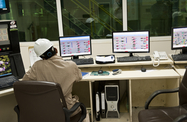From the start of this year, Oman has doubled gas tariffs for industrial producers, with the move expected to squeeze margins for operators. However, the higher prices may spur a move towards greater efficiency, which could benefit the sector over the long-term.
Approved in January, the price of natural gas to companies has doubled from a rate of $1.50 per million British thermal units (BTU) to $3 per million BTU, with the provision for annual increases of 3% in subsequent years. The raise is in part a response from the authorities looking to bridge some of the gap in the national budget left by weaker hydrocarbons revenue.
But the increase has led to those in the industrial sector warning that the sultanate’s competitive edge will be dulled by higher costs, and could stoke inflation. The two main cement producers, Raysut Cement and Oman Cement, have said that production costs will increase dramatically under the new price scheme, with officials from the two firms quoting increases in expenses of OR4.5m ($11.8m) and OR6.6m ($17.1m), respectively, after the hike was announced.
Bright prospects
Weaker oil prices are set to have a significant impact on Oman this year, pushing both the budget and current accounts into a possible deficit, according to a report by the US-based Institute of International Finance (IIF) released in March. This will be partly offset by growth in the non-oil sector and possible cost-cutting measures by the government.
The non-oil sector, driven in part by industry, is pegged to lead growth in 2015, with non-hydrocarbon GDP forecast to rise by 4.8%, compared to a 4.5% increase for the broader economy according to the IIF report. These figures fall short of the 7.2% non-oil growth estimated for 2014 and 10.8% recorded in 2012.
According to the IIF, one upside to a drop in energy revenue for countries like Oman is an acceleration of moves towards economic diversification and greater energy efficiency. “Prospects further out remain bright,” the report noted. “Industrial development and economic diversification should continue to bear fruit and will be supported by a sharp increase in gas production over the next five years, which is critical as a feedstock for downstream projects being developed at Duqm and Sohar.”
Calls for cuts
In early March the IMF’s country head, Ananthakrishnan Prasad, said that Oman needed to implement reforms to keep its deficit in check, with the scaling back of gas and energy subsidies at the top of the list of priorities. If adopted, the measures would further impact Omani industries, with those in the rapidly developing petrochemicals sector hit with higher raw materials prices and power dependent producers confronted with steeper electric bills.
N A Ansari, the CEO of iron & steel producer Jindal Shadeed, Oman, sees the rise in gas tariffs as untimely. “In the present critical market scenario, the gas price increase would adversely affect the survival of integrated steel plants” he told OBG. “Internally we will continue to take all possible actions to reduce the impact through cost control measures in all the activities of plant operations”.
Manufacturers also fear higher fuel expenses will have a negative ripple effect. “There will be pressure on the government to reduce subsidies, which may lead to an increase in input costs,” S. Gopalan, the CEO of car battery manufacturer Reem Batteries & Power Appliances, told OBG. “This could lead to a cascade effect across the supply chain.”
Although rising domestic power demands and falling world commodities prices have led to a dimmer short-term forecast, Oman’s industrial sector is expected to continue on a long-term upwards trajectory, with a host of value-added processing projects now under development across the country.
Furthermore, a tighter business environment may act as a catalyst for operational efficiencies, which could offset more costly inputs. “Industry can thrive in Oman, but only in highly-automated and capital-intensive sectors, and not in labour-intensive sectors,” said Gopalan. “Technology, in this regard, could play a big role to maximise output with less labour.”

